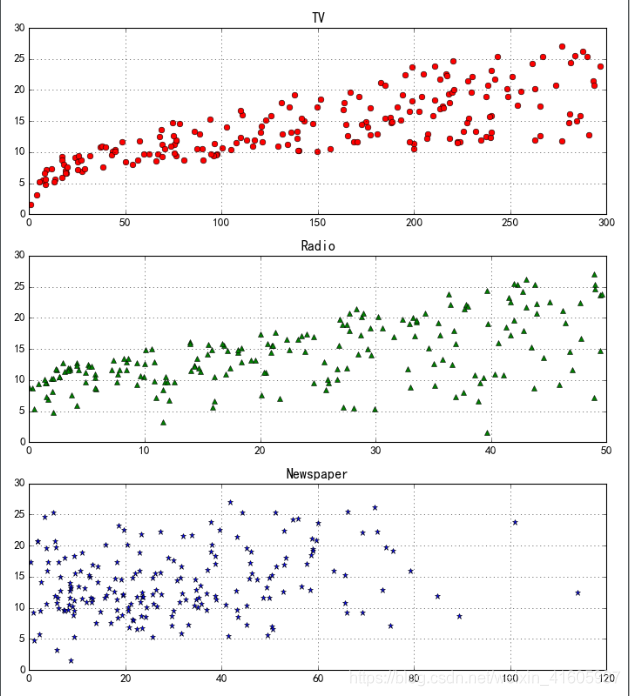机器学习有关线性相关的实例:有关于广告的预测模型
本文共 3094 字,大约阅读时间需要 10 分钟。


#导入相关的包import numpy as npimport matplotlib as mplimport matplotlib.pyplot as pltimport pandas as pdfrom sklearn.model_selection import train_test_splitfrom sklearn.linear_model import LinearRegressionif __name__ == "__main__": path = 'Advertising.csv'#文件的路径 # pandas读入 data = pd.read_csv(path) # TV、Radio、Newspaper、Sales x = data[['TV', 'Radio', 'Newspaper']] #x = data[['TV', 'Radio']] y = data['Sales'] mpl.rcParams['font.sans-serif'] = [u'simHei'] mpl.rcParams['axes.unicode_minus'] = False # 绘制1 plt.figure(facecolor='w') plt.plot(data['TV'], y, 'ro', label='TV') plt.plot(data['Radio'], y, 'g^', label='Radio') plt.plot(data['Newspaper'], y, 'mv', label='Newspaer') plt.legend(loc='lower right') plt.xlabel(u'广告花费', fontsize=16) plt.ylabel(u'销售额', fontsize=16) plt.title(u'广告花费与销售额对比数据', fontsize=20) plt.grid() plt.show() # 绘制2右下角的那个小的图框 plt.figure(facecolor='w', figsize=(9, 10)) plt.subplot(311) plt.plot(data['TV'], y, 'ro') plt.title('TV') plt.grid() plt.subplot(312) plt.plot(data['Radio'], y, 'g^') plt.title('Radio') plt.grid() plt.subplot(313) plt.plot(data['Newspaper'], y, 'b*') plt.title('Newspaper') plt.grid() plt.tight_layout() plt.show() x_train, x_test, y_train, y_test = train_test_split(x, y, train_size=0.8, random_state=1)#这里使用了函数的交叉验证集的问题80%的测试20%的验证集 print(type(x_test)) print("x_train.shape=",x_train.shape,"y_train.shape=", y_train.shape) linreg = LinearRegression()# 使用线性回归模型 #linreg = Lasso() """#另一种数据降维方法,该方法不仅适用于线性情况,也适用于非线性情况。Lasso是 基于惩罚方法对样本数据进行变量选择,通过对原本的系数进行压缩,将原本很小的系数直接压缩至0,从而将这部分系数所对应的变量视为非显著性变量,将不显著的变量直接舍弃。""" #linreg = Ridge()#使用的是岭回归模型 model = linreg.fit(x_train, y_train) print("model=",model) print("linreg.coef_",linreg.coef_,"linreg.intercept_",linreg.intercept_)#输出了系数矩阵 order = y_test.argsort(axis=0)#argsort()函数是将x中的元素从小到大排列 y_test = y_test.values[order] x_test = x_test.values[order, :] y_hat = linreg.predict(x_test) mse = np.average((y_hat - np.array(y_test)) ** 2) # Mean Squared Error rmse = np.sqrt(mse) # Root Mean Squared Error print('MSE = ', mse, ) print('RMSE = ', rmse) print('R2 = ', linreg.score(x_train, y_train)) print('R2 = ', linreg.score(x_test, y_test)) plt.figure(facecolor='w') t = np.arange(len(x_test)) plt.plot(t, y_test, 'r-', linewidth=2, label=u'真实数据') plt.plot(t, y_hat, 'g-', linewidth=2, label=u'预测数据') plt.legend(loc='upper right') plt.title(u'线性回归预测销量', fontsize=18) plt.grid(b=True) plt.show()

总结:这里是预测函数主要使用了 LinearRegression()# 使用线性回归模型。这个是sklearn自带的函数.


其中在sklearn自带的函数.几个常用的函数
fit(X,y, [sample_weight]) # 拟合线性模型
-X:训练数据,形状如 [n_samples,n_features]
-y:函数值,形状如 [n_samples, n_targets]
-sample_weight: 每个样本的个体权重,形状如[n_samples]
get_params([deep]) # 获取参数估计量set_params(**params) # 设置参数估计量
predict(X) # 利用训练好的模型进行预测,返回预测的函数值-X:预测数据集,形状如 (n_samples, n_features)
score(X, y, [sample_weight]) # 返回预测的决定系数R^2-X;训练数据,形状如 [n_samples,n_features]
-y;关于X的真实函数值,形状如 (n_samples) or (n_samples, n_outputs)
-sample_weight:样本权重
转载地址:http://bujh.baihongyu.com/
你可能感兴趣的文章
Node-RED中使用Notification元件显示警告讯息框(温度过高提示)
查看>>
Node-RED中使用range范围节点实现从一个范围对应至另一个范围
查看>>
Node-RED中实现HTML表单提交和获取提交的内容
查看>>
Vue3+elementplus实现图片上传下载(最强实践)
查看>>
Node-RED中将CSV数据写入txt文件并从文件中读取解析数据
查看>>
Node-RED中建立TCP服务端和客户端
查看>>
Node-RED中建立Websocket客户端连接
查看>>
Node-RED中建立静态网页和动态网页内容
查看>>
Vue3+Element-ul学生管理系统(第二十二课)
查看>>
Node-RED中怎样让网站返回JSON数据
查看>>
Node-RED中根据HTML文件建立Web网站
查看>>
Node-RED中解析高德地图天气api的json数据显示天气仪表盘
查看>>
Node-RED中连接Mysql数据库并实现增删改查的操作
查看>>
Node-RED中通过node-red-ui-webcam节点实现访问摄像头并截取照片预览
查看>>
Node-RED中配置周期性执行、指定时间阶段执行、指定时间执行事件
查看>>
Node-RED安装图形化节点dashboard实现订阅mqtt主题并在仪表盘中显示温度
查看>>
Node-RED怎样导出导入流程为json文件
查看>>
Node-RED简介与Windows上安装、启动和运行示例
查看>>
Node-RED订阅MQTT主题并调试数据
查看>>
Node-RED通过npm安装的方式对应卸载
查看>>